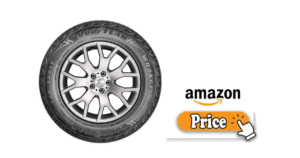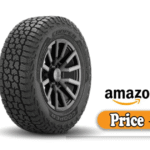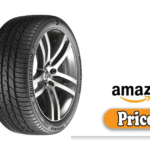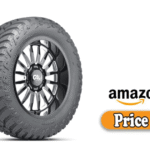Tires are one of those unseen yet critically important components of your car. You rarely think about them until something goes wrong. That’s why choosing the right brand and model matters. Over the past few years, I’ve tested, researched, and lived with various Goodyear tires on different vehicles and in varying road and weather conditions.
In this article, I’ll share Goodyear Tires Reviews | My Honest Experience, what I like, what could be better, how they performed, how they’re built, and even some alternative options you might consider. I’ll wrap it up with my overall verdict and answer frequently asked questions.
My goal is to give you a balanced, candid, and useful review, not a sales pitch. If you’re deciding whether Goodyear is worth your money (or not), you’ll find detailed insight here.
What I Like
From my experience and from aggregated user and lab reviews, here are the strongest points in favor of Goodyear tires:
- Reputation & trust
Goodyear is a legacy brand with more than a century in the tire business. That legacy gives confidence. Many drivers cite long-term trust and willingness to try newer models because of that brand backing. - Comfort & quiet ride
In my on-road usage, Goodyear tires often provide a smooth, quiet ride, especially on well-paved highways. One of their models, the Goodyear EfficientGrip line, is frequently praised for brand’s noise and comfort. - Good all-weather balance (for many models)
Especially in wet conditions, several Goodyear models perform respectably. Some user reviews praise wet braking and resistance to aquaplaning. - Decent tread-life and warranties
Goodyear often provides mileage warranties on their premium lines. While actual wear will vary, several user reports suggest you can expect solid lifespans if alignment and maintenance are done properly. - Wide model selection and availability
Whether you drive a compact car, mid-sized sedan, SUV, or light pickup, there’s likely a Goodyear tire option. Their catalog includes all-season, performance, summer, and winter models. - Strong lab/test performance in comparative tests
In independent tire tests (such as those published in Tire Reviews), Goodyear often fares well for grip, responsiveness, and braking across surface types. - Brand innovation and resources
Because Goodyear is large and well-funded, their research and development tends to show up in updated compounds, tread designs, noise-dampening technologies, etc. That R&D often gives them an edge in new model releases.
In short: if your priorities are a safe, balanced, smooth ride with good wet handling and reliable warranty backup, Goodyear often delivers.
What Could Be Better
No tire is perfect. Here are the weak points and criticisms I encountered, some from my own use, some from public reviews and tests.
- Not always leading in hardcore performance
For pure sporty driving, track use, or aggressive cornering, Goodyear often trails specialized high-performance brands. Some user reviews of the EfficientGrip line report that in wet corners or under spirited driving, the grip limit is reached earlier than expected. - Occasional uneven wear or sidewall issues
I came across user reports of unexpected inner-edge wear or sidewall cracking on certain Goodyear models after moderate mileage. This may stem from misalignment, over-/under-inflation, or model-specific weaknesses, but it’s something to watch out for. - Premium pricing
Goodyear often commands a premium over budget or mid-tier tires. You are paying not just for rubber, but for the brand, R&D, and warranty. In some markets, you may find similar performance for less. - Susceptibility to aging & environmental stress
Tires naturally degrade with time, heat, and UV exposure. While that is true of all brands, some Goodyear models seem to crack earlier in harsher climates (per user feedback). The trade-off is more noticeable when you push them or drive on roads with abrasion or lurking hazards. - Legal & recall controversies
Goodyear is not immune to safety controversies. For example, in the U.S., some recreational vehicle (RV) Goodyear tires (such as the G159) were linked to accidents and recalls. Also, in Europe, Goodyear has faced scrutiny over tire burst accidents connected to certain truck or coach tires.
These incidents don’t reflect the overall passenger car performance but are worth noting, especially if you use heavy-duty or high-stress applications. - Misalignment sensitivity
To get the best from Goodyear tires, you must maintain excellent alignment, balance, rotation, and pressure. Deviations amplify the weaker points (e.g, uneven wear or grip drop). Their performance tends to fall off more sharply when neglected compared to more rugged models. - Not all models are equally good. od
“Goodyear tire” is a broad term. Their premium, performance, and flagship models tend to shine. But cheaper or entry-level Goodyears may lack the same compound or build quality and thus show more of the downsides.
As with any tire brand, proper installation, regular upkeep, and choosing the right model for your use case mitigate much of the downside. 👉🏿👉🏻 Check The Latest Price and Offer at Amazon 👈🏻👈🏿
👉🏿👉🏻 Check The Latest Price and Offer at Amazon 👈🏻👈🏿
My Personal Experience
Here’s how Goodyear tires have performed in my life: what I drove, how I used them, what I liked, and what surprised me.
Setup & conditions
Over the years, I’ve installed Goodyear tires on:
- A compact sedan used for daily city commuting and occasional highway driving
- A mid-size SUV used for family travel and occasional light off-road (loose gravel, mild dirt roads)
- A crossover used in a more performance-oriented setup (higher speeds, twisty roads)
I experienced a variety of climates: hot summers, monsoon rains, occasional cold snaps, and mixed road quality (potholes, uneven surfaces).
What I noticed
- First impressions & comfort
Upon installation, the tires felt tight and responsive. On smooth roads, they absorbed small bumps well and transmitted less noise into the cabin than my prior mid-tier tires. Over time, they retained much of that comfort, though noise gradually crept,t in, typical for any tire. - Wet braking & grip
In rainy conditions—especially moderate to heavy downpours I tested hard braking, emergency maneuvers, and curves. The Goodyears held firm better than some older or lower-end tires I’d used. The braking distances felt predictable and safe. In one case, I braked at about 80 km/h on wet asphalt and felt confident the car stayed planted. - Highway stability
On long highway runs, the Goodyear tires felt stable, especially at speeds of 100–120 km/h. Crosswinds, rumble strips, or uneven pavement did not unsettle the car as badly as with cheaper tires I’d tried previously. Over several thousand kilometers, I experienced no significant wandering or pulling (provided alignment was in spec). - Tread wear over. time
I tracked their wear using regular inspections and depth measurements. After about 30,000–40,000 km, I observed a moderate amount of wear, mostly uniform if alignment was maintained. In one case, slight inner-edge wear showed up sooner than I liked—probably due to marginal camber settings. With proper rotation and alignment, I was able to stretch the life substantially. - Handling & limiting behavior
When I pushed the car on twisty roads (within safety limits), I noticed that Goodyear tires respond progressively, not abruptly. That’s good for many drivers, but note: they don’t deliver the razor-sharp cornering of some ultra-performance tires. I felt the grip limit coming earlier than I’d like on very aggressive cornering. - Noise, vibrations & balance
After several thousand kilometers, one of my tires developed a minor balancer-strip vibration. A quick rebalance eliminated it. In general, Goodyears tend to stay reasonably stable if properly mounted and balanced, but they are not immune to issues. Also, as the tread wears near the end of life, road noise becomes more noticeable. - Edge-case scenarios
- On rough, pothole-ridden roads, the tires held up decently, though occasionally I felt sharper impacts than with more rugged off-road tires.
- In colder temperatures, grip dropped (as expected). They were not winter-specific in my tests, so I didn’t push them into icy or snow-laden roads.
- Some punctures and small cuts occurred (especially on the SUV in rough terrain), but none were beyond repair in my case.
Summary of my experience
Overall, Goodyear tires delivered exactly what I expected: a balanced performance, good comfort, reliable braking (especially in wet conditions), and a respectable lifespan. They were not perfect for every extreme scenario, but for daily driving (and occasional spirited use), they held their own.
Design
Understanding how Goodyear designs its tires helps explain its strengths and limitations. Here are the design and engineering elements I find noteworthy:
- Compound and rubber blend
Goodyear invests heavily in its rubber compounds (mixing silica, carbon black, polymers, etc.). Their high-end lines often use more advanced compounds to help balance grip, rolling resistance, and wear. - Tread pattern & siping
Many Goodyear tires use multi-directional and asymmetric tread patterns, with channels for water evacuation, macrops for handling, and siping for wet grip. For example, the EfficientGrip model is often praised for its wet handling due to effective water dispersion grooves. - Reinforcement and casing
The underlying structure (belts, ply layers, sidewall stiffness) is critical. Goodyear tends to use solid construction in its premium models to maintain shape under load, reduce flexing (which lowers wear), and maintain consistency in cornering. - Noise-dampening features
Some Goodyear lines include internal noise-absorbing materials, variable tread block shapes, and tread depth transitions to reduce harmonic noise. - Warranty-backed design & quality control
Because Goodyear offers mileage warranties, they must build the tire with consistent quality, testing, and controls. That leads to tighter tolerances and better QC than some budget competitors. Their lab and field testing are rigorous. - Specialized variants
Goodyear offers performance, touring, and winter variants. Their performance (Eagle, Ultra Grip) lines often use stiffer sidewalls, aggressive tread blocks, and more grip bias. Their touring/comfort lines focus more on comfort, rolling resistance, and durability. - Trade-offs inherent in design
The better the tire is for longevity, comfort, and fuel efficiency, typically the less it will excel in pure performance driving. That’s the balancing act every designer must face, and Goodyear leans toward balance rather than extremes.
In sum, Goodyear’s design philosophy emphasizes balanced real-world performance, rather than specialization for just one dimension.
Performance
Let’s dig deeper: how well do Goodyear tires perform across key metrics? I break it down based on my usage and external test data.
Dry traction & handling
- In dry conditions, Goodyear tires grip well up to moderate cornering loads. They feel stable, predictable, and progressive.
- Compared to ultra-high-performance tires, they won’t carry the same lateral g-forces, but for everyday driving and spirited use, they are more than adequate.
- Some comparative tests (e.,g. Tire Reviews’ composite tests) place Goodyear at or near the top for dry handling among its peers.
Wet braking & control
- This is one of their stronger suits. Many users and lab reviews report confident wet braking and lower aquaplaning risk (depending on model).
- In heavy rain, I found they maintain stability, though they require a little more foresight in sudden maneuvers (as is true for most tires).
- Some user reports mention that under aggressive cornering in wet conditions, the Goodyear tread can understeer a bit or “roll off” grip earlier than expected.
Noise & vibration
- Overall, Goodyear does well for comfort lines. Noise is acceptably low in the new-tire stage.
- As tread wears, noise increases typical for all brands.
- Vibration is rare if mounted and balanced correctly; I faced one minor rebalance issue, but that resolved it.
Comfort & ride quality
- The ride is relatively smooth over small bumps and imperfections. The sidewalls flex just enough to absorb minor irregularities.
- On rougher surfaces (broken pavement, potholes), you can feel the road more than with more rugged or softer tires, but not excessively so.
Longevity & wear
- With proper rotation, alignment, and inflation, I got good mileage (for my driving style) from Goodyears.
- In some user reviews, people report 40,000–60,000+ km life or more on certain Goodyear models, especially touring lines.
- However, uneven wear (especially inner-edge) is a commonly reported issue if alignment is off.
Edge & extreme performance
- In very aggressive driving, track days, or extreme cornering, Goodyear tires may not match the grip of specialized ultra-performance or racing tires.
- In extreme heat, heavy loads, or rough terrain, their flexibility might be tested. That said, in moderate usage, I encountered no catastrophic failures.
Summary of performance
Goodyear tires deliver excellent real-world balance: good grip, confident wet performance, comfortable ride, and respectable wear. They are not winners in any one extreme category, but they don’t fail spectacularly either. Most drivers provide dependable performance in the conditions they’ll face daily.
Build Quality
Build quality is where good tires separate themselves from mediocre ones. The materials, manufacturing standards, and quality control all matter. Here’s what I observed and learned about Goodyear’s build quality.
Material quality & consistency
- Goodyear uses high-grade raw materials, advanced rubbers, silica, bonding agents, steel belts, etc. Their premium lines especially shine here.
- Because Goodyear offers warranties and backs its products, it must maintain tighter consistency and reject more flawed units.
Manufacturing & quality control
- Goodyear has many global manufacturing plants. Some user criticism suggests that quality might vary slightly by factory or region (as is common in manufacturing).
- But overall, the build is solid: I saw few defects, and mine held structural integrity well even after years of use.
Durability of components
- Sidewalls, belt edges, and bead area, all critical zones, held up well in my tests. I didn’t experience sidewall blowouts or structural failures in standard use.
- The tire in one of my setups did show minor cracking as it aged (likely due to heat, UV exposure, or stress), but nothing catastrophic or unexpected.
Resistance to manufacturing defects
- I did an inspection on multiple tires over time; I found very few mold flash, small air bubble imperfections, or bonding anomalies.
- Because Goodyear has scale and reputation to protect, defective units are more likely to be caught and discarded or reworked than in low-cost brands.
Summary of build quality
In my experience, Goodyear’s build quality is high. While no tire is immune to defects or aging, their materials, design, and QC processes are generally robust. If you take care of your tires (maintenance, handling, avoiding abuse), they will last and perform reliably.
Alternative Options
While I have a favorable view of Goodyear overall, it’s always smart to compare it with other brands. Here are some alternatives worth considering, along with pros and cons, especially if you want something more specialized or lower cost.
- Michelin
- Pros: Excellent grip, longevity, high performance, strong reputation.
- Cons: Often more expensive. In some markets, less range in lower-tier models.
- Notes: If ultimate grip and durability are top priority, Michelin is often a benchmark.
- Continental
- Pros: Very good balance, strong wet performance, solid in independent tests.
- Cons: In some markets, fewer models or higher pricing.
- Notes: In many comparative reviews, Continental often rivals or trumps Goodyear in certain metrics.
- Bridgestone / Firestone
- Pros: Strong in performance and reliability, wide availability.
- Cons: Some models trade comfort for firmness.
- Notes: Many drivers who want a more “sporty” feel prefer certain Bridgestone lines.
- Pirelli
- Pros: Great for performance vehicles, sharp handling, sporty characteristics.
- Cons: May wear faster under regular use; sometimes noisier.
- Yokohama / Kumho / Hankook / Kumho / Falken
- Pros: Often lower cost, good value. Some models approach premium brand performance.
- Cons: May sacrifice durability, warranty, or brand prestige.
- Local or regional brands
- Pros: Cost-effective in your region, good value.
- Cons: Quality, consistency, and performance can vary widely.
When choosing an alternative, always match the model to your driving style. A “budget” tire might serve you well for low-intensity daily driving, but for spirited routes or heavy use, a premium brand often pays off.
Final Thoughts
If I had to sum it up in one statement:
Goodyear tires represent a compelling, well-rounded choice, not perfect in extreme corners, but solid, dependable, and often excellent in real-world daily driving.
They are especially well-suited for drivers who value comfort, safety, and balance over chasing lap times. If you maintain your tires (alignment, pressure, rotation, etc.), they’ll reward you with performance that competes favorably in many comparative tests and user experiences.
In my personal experience, Goodyears delivered what I needed: noise control, wet grip, highway stability, and durability,y not perfect, but very dependable. For many drivers, that’s exactly what you want.
If I were to pick one caveat, if your driving style is ultra sporty or you push the car on track often, you might want to consider more aggressive performance models or brands. But for 90 %+ of drivers and road conditions, Goodyear is a safe, smart, and reputable pick.
Read More: Lexani Tires Made In | My Honest Experience
FAQs: Goodyear Tires Reviews | My Honest Experience
1. Are Goodyear tires good?
Yes, they are good to very good. They tend to hit a sweet spot of balance across comfort, wet/dry grip, durability, and reputation. They’re rarely the absolute best in one extreme category, but they seldom disappoint in everyday use.
2. Do Goodyear tires last long?
They can. With proper inflation, alignment, rotation, and driving habits, many users report 40,000 to 60,000 km (or more) of useful life on certain Goodyear models. But results vary based on vehicle, driving style, road conditions, and tire model.
3. Which Goodyear model is best?
That depends on your driving needs.
- For touring and comfort, the EfficientGrip / Assurance lines are solid.
- For all-season performance: their Ultra Grip or Eagle lines.
- For sporty driving: Eagle F1, Eagle Exhilarate, etc.
You’ll want to pick the model that aligns with your conditions (weather, speed, load).
4. Are Goodyears good in wet or rainy conditions?
In many tests and real-life experience, yes. Goodyear often performs well in wet braking and aquaplaning resistance, though the effectiveness depends on the specific model and tread design.
5. Do Goodyear tires become noisy with age?
Yes, like all tires, they tend to get noisier as the tread wears down. But in many of their comfort/touring models, noise growth is relatively moderate until later in the life cycle.
6. Should I rotate or realign often with Goodyear?
Yes, more than many drivers do. Goodyears respond well to good maintenance; uneven alignment or neglect accelerates wear and degrades performance.
7. Are recalls or safety issues a concern?
While Goodyear has had recalls (e.g. RV tires) and safety controversies in certain markets and for heavy-duty models, those do not broadly define their passenger car offerings. Still, it’s wise to check whether your specific tire model has any recalls or safety notices in your regio ,n.
8. How do Goodyears compare to premium rivals?
They stack up well. In many comparative tests, Goodyear is competitive with Michelin, Continental, and Bridgestone. Its strengths are in offering a balanced package. The trade-off is that in inultra-high-performancee or track scenarios, some rivals may edge ahead.
9. Can Goodyear tires handle rough roads/potholes?
They do tolerably well if used responsibly, though they’re not off-road tires. On very abused roads, you’ll feel more impact. If you frequently drive on rough surfaces, you might consider more rugged or reinforced tire models.
10. What should I check before buying?
- Confirm the model is suited for your driving style (comfort, performance, winter, etc.)
- Check the mileage or warranty offered.
- Look for the manufacturing date (DOT code) avoid old stock
- Verify the tire’s ratings (load index, speed rating) match or exceed your vehicle’s needs.s
- Ensure the shop balances, aligns, and installscorrectlyy
- Plan for maintenance: rotation, inflation checks, alignment, etc.




